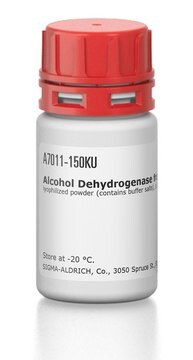N7160
NAD-ADH Reagent Multiple Test Vial
for alcohol determination
Synonym(s):
Ethanol assay reagent
Sign Into View Organizational & Contract Pricing
All Photos(1)
About This Item
UNSPSC Code:
41106305
NACRES:
NA.51
Recommended Products
Application
NAD-ADH Reagent Multiple Test Vial has been used to determine the alcohol content in blood. It has also been used to detect ethanol levels in mice.
Biochem/physiol Actions
Alcohol dehydrogenase (ADH) catalyzes the oxidation of alcohol to acetaldehyde with the simultaneous reduction of nicotinamide adenine dinucleotide (NAD) to NADH. The consequent increase in absorbance at 340 nm is directly proportional to alcohol concentration in the sample.
Other Notes
Vial contains ≥10 μmol of nicotinamide adenine dinucleotide (NAD) and ≥800 units of yeast alchohol dehydrogenase (ADH), buffer salts, and stabilizers.
signalword
Danger
hcodes
pcodes
Hazard Classifications
Resp. Sens. 1
Storage Class
11 - Combustible Solids
wgk_germany
WGK 3
flash_point_f
Not applicable
flash_point_c
Not applicable
ppe
Eyeshields, Gloves, type N95 (US)
Choose from one of the most recent versions:
Certificates of Analysis (COA)
Lot/Batch Number
Don't see the Right Version?
If you require a particular version, you can look up a specific certificate by the Lot or Batch number.
Already Own This Product?
Find documentation for the products that you have recently purchased in the Document Library.
ADH Cluster Genes, Genome-Wide Association Studies, and Alcohol Dependence
Park BL and Shin HD
Neuropathology of Drug Addictions and Substance Misuse, 520-530 (2016)
Ethanol Metabolism and Implications for Disease
Rajendram R, et al.
Neuropathology of Drug Addictions and Substance Misuse, 377-388 (2016)
Tatsuro Kumada et al.
The Journal of neuroscience : the official journal of the Society for Neuroscience, 26(3), 742-756 (2006-01-20)
The brains of fetal alcohol syndrome patients exhibit impaired neuronal migration, but little is known about the mechanisms underlying this abnormality. Here we show that Ca2+ signaling and cyclic nucleotide signaling are the central targets of alcohol action in neuronal
Ajay C Donepudi et al.
Hepatology communications, 2(1), 99-112 (2018-02-07)
Alcoholic fatty liver disease (AFLD) is a major risk factor for cirrhosis-associated liver diseases. Studies demonstrate that alcohol increases serum bile acids in humans and rodents. AFLD has been linked to cholestasis, although the physiologic relevance of increased bile acids
Ana M Romero et al.
Neurotoxicity research, 29(1), 69-79 (2015-08-13)
Chronic alcohol consumption may cause neurodevelopmental and neurodegenerative disorders. Alcohol neurotoxicity is associated with the production of acetaldehyde and reactive oxygen species that induce oxidative DNA damage. However, the molecular mechanisms by which ethanol disturbs the DNA damage response (DDR)
Our team of scientists has experience in all areas of research including Life Science, Material Science, Chemical Synthesis, Chromatography, Analytical and many others.
Contact Technical Service








